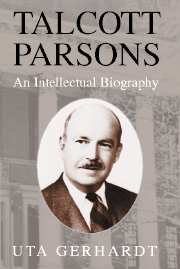Book contents
- Frontmatter
- Contents
- Preface
- 1 Understanding The Structure of Social Action
- 2 Parsons's Sociology of National Socialism, 1938–1945
- 3 The Harvard Social-Science War Effort and The Social System
- 4 A New Agenda for Citizenship: Parsons's Theory and American Society in the 1960s
- Epilogue: A Life of Scholarship for Democracy
- Biblography
- Name Index
- Subject Index
- Plate section
2 - Parsons's Sociology of National Socialism, 1938–1945
Published online by Cambridge University Press: 09 October 2009
- Frontmatter
- Contents
- Preface
- 1 Understanding The Structure of Social Action
- 2 Parsons's Sociology of National Socialism, 1938–1945
- 3 The Harvard Social-Science War Effort and The Social System
- 4 A New Agenda for Citizenship: Parsons's Theory and American Society in the 1960s
- Epilogue: A Life of Scholarship for Democracy
- Biblography
- Name Index
- Subject Index
- Plate section
Summary
Introduction
Secondary reconstruction of Parsons's oeuvre has it that the time period of the two classics, Structure published in 1937, and The Social System which first appeared in 1951, were an “early” and a “period”, respectively. Two decades of theory endeavor, subsequent to Structure, supposedly led up to eventual development of a “late period” featuring a multidimensional systems analytical approach. The “middle period”, continuing from Structure, apparently incorporated above all The Social System as an epitome of systematic, abstract theory.
This categorization of Parsons's oeuvre lumps together as “middle period” two phases in American history that were remarkably different when both had an impact on his work. They were the era of World War II, until 1945, and that of the postwar period including the emergent Cold War in the years culminating in the outbreak of the Korean War.
In this chapter, I wish to argue that World War II was a backdrop to a special phase in Parsons's work. I suggest that he proposed a sociology of National Socialism, counterpart to his analysis of democracy featuring American democracy.
Parsons's sociology of National Socialism followed from his two-pronged theory of the structure of (systems of) social action. In Structure, he elaborated on two types of social system, indirectly contrasting then contemporary societies, the United States and Nazi Germany. This chapter renders further credence to the viewthat he had contemporary society in mind.
- Type
- Chapter
- Information
- Talcott ParsonsAn Intellectual Biography, pp. 58 - 128Publisher: Cambridge University PressPrint publication year: 2002



